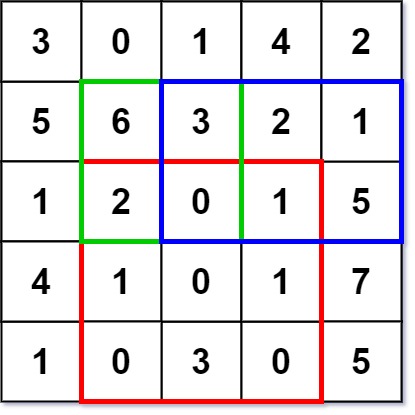LeetCode in Kotlin
304. Range Sum Query 2D - Immutable
Medium
Given a 2D matrix matrix, handle multiple queries of the following type:
- Calculate the sum of the elements of
matrixinside the rectangle defined by its upper left corner(row1, col1)and lower right corner(row2, col2).
Implement the NumMatrix class:
NumMatrix(int[][] matrix)Initializes the object with the integer matrixmatrix.int sumRegion(int row1, int col1, int row2, int col2)Returns the sum of the elements ofmatrixinside the rectangle defined by its upper left corner(row1, col1)and lower right corner(row2, col2).
Example 1:

Input
["NumMatrix", "sumRegion", "sumRegion", "sumRegion"]
[[[[3, 0, 1, 4, 2], [5, 6, 3, 2, 1], [1, 2, 0, 1, 5], [4, 1, 0, 1, 7], [1, 0, 3, 0, 5]]], [2, 1, 4, 3], [1, 1, 2, 2], [1, 2, 2, 4]]
Output: [null, 8, 11, 12]
Explanation:
NumMatrix numMatrix = new NumMatrix([[3, 0, 1, 4, 2], [5, 6, 3, 2, 1], [1, 2, 0, 1, 5], [4, 1, 0, 1, 7], [1, 0, 3, 0, 5]]);
numMatrix.sumRegion(2, 1, 4, 3); // return 8 (i.e sum of the red rectangle)
numMatrix.sumRegion(1, 1, 2, 2); // return 11 (i.e sum of the green rectangle)
numMatrix.sumRegion(1, 2, 2, 4); // return 12 (i.e sum of the blue rectangle)
Constraints:
m == matrix.lengthn == matrix[i].length1 <= m, n <= 200-105 <= matrix[i][j] <= 1050 <= row1 <= row2 < m0 <= col1 <= col2 < n- At most
104calls will be made tosumRegion.
Solution
class NumMatrix(matrix: Array<IntArray>) {
private val m = matrix.size
private val n = if (m > 0) matrix[0].size else 0
var array = Array<IntArray> (m + 1) { IntArray(n + 1) }
init {
for (i in 1..m) {
for (j in 1..n) {
array[i][j] = matrix[i - 1][j - 1] + array[i][j - 1] + array[i - 1][j] - array[i - 1][j - 1]
}
}
}
fun sumRegion(row1: Int, col1: Int, row2: Int, col2: Int): Int {
return array[row2 + 1][col2 + 1] - array[row2 + 1][col1] - array[row1][col2 + 1] + array[row1][col1]
}
}
/*
* Your NumMatrix object will be instantiated and called as such:
* var obj = NumMatrix(matrix)
* var param_1 = obj.sumRegion(row1,col1,row2,col2)
*/

